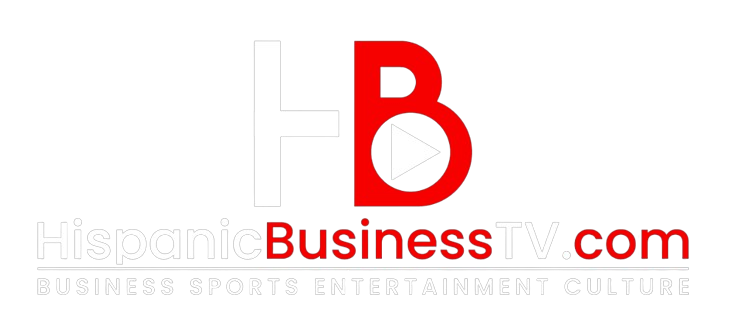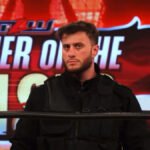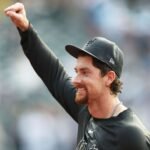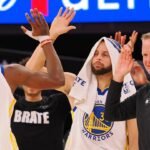Here are a list of winners and losers with grades and comments.
Utah Jazz
Ace Bailey tried playing a game of chicken with Danny Ainge and lost, as the Jazz president, along with his general manager, son Austin, took the mercurial Rutgers guard fifth overall despite having a slew of impactful choices with that pick. There have been players who refused to play for the teams that drafted them, such as Steve Francis nearly 30 years ago, but that won’t be the case with Bailey. The Jazz got themselves the second-best prospect at No. 5, then took, guard Walter Clayton Jr. with the 18th pick. The Jazz have been in tank mode long enough. They needed to make a splash and selected two players who could make significant impacts.
GRADE: A
Washington Wizards
The Wizards are being real about their rebuild. They’re not going to make the playoffs next season so they stacked prospects as they prepare to make a free-agent splash in 2026. Tre Johnson, selected sixth, could pair with Bub Carrington for a dynamic frontcourt in coming years. Johnson needs work on defense but he shot nearly 40 percent on 3-pointers as a freshman at Texas and could turn into a prolific scorer. Will Riley, taken 21st, will battle it out with the other young swingmen for playing time, but like the Thunder, the Wizards are packing their roster with prospects and banking that the best will become stars. Jamir Watkins, a Florida State product taken 43rd overall, should contend for a roster spot.
GRADE: A-
Charlotte Hornets
It’s been a difficult several years and it got worse when they slipped to fourth overall in the lottery despite having one of the league’s worst records. But general manager Jeff Peterson made the best of the situation by taking four solid players who can add to a new culture. Fourth overall pick Kon Knueppel had a solid freshman season at Duke, shooting 40 percent from the 3-point line and should compete for small-forward minutes. Liam McNeeley probably should have stayed at UConn for another season as he slipped to 29, and the Hornets jumped into the first round to take him. Sion James and Ryan Kalkbrenner could have been worthy of the first round, but the Hornets took them with consecutive picks (33 and 34) to add depth.
GRADE: A-
Orlando Magic
The Magic have drafted a litany of lottery picks over the years to uneven success but they moved one of their first-rounders to Memphis in the Desmond Bane deal, then selected at No. 25 to take Jase Richardson, a freshman who was arguably Michigan State’s t best player at season’s end. Orlando is desperate for offense and Richardson could serve as a solid backup to Bane. Orlando then traded with the Celtics to take Noah Penda, a 20-year-old French prospect who could become a rotation player.
GRADE: B
San Antonio Spurs
They took advantage of their lottery luck, selecting Dylan Harper second overall, then capitalized on the first-rounder they received from the Hawks in the Dejounte Murray deal to take Arizona freshman Carter Bryant at No. 14. The Spurs are finished rebuilding. Adding an immediate impact rookie such as Harper and a workhorse such as Bryant into their culture will help their ascension.
GRADE: B
LOSERS
Portland Trail Blazers
Drafting Chinese center prospect Yang Hansen probably was the most bizarre first-round pick in several years. Very rarely do 16th overall picks sit in the stands during the draft but he was there as a fan, clad in a white suit. As much help as the Blazers need, taking a chance on an unproven prospect, especially at a position where they are deep, is curious at best. The Blazers came away with nothing else on draft night, meaning Hansen better be worth the investment.
Brooklyn Nets
The general assumption around the NBA was the Nets would trade at least one of their five first-round picks. Most teams don’t need five rookies because that’s a lot of roster space for players who may not be ready for the NBA rigors. But the Nets ignored conventional theory and have all five, at least for now. They could have potentially moved a pick or two for a veteran or even a future first-rounder. All five may eventually turn into starters and rotation players but the learning curve could outlast general manager Sean Marks, who has done a less than impressive job in Brooklyn.
How the West was won
Thunder seem to have blueprint
The Thunder not only won the NBA championship but they have set the blueprint for organizational success.
How do veteran teams such as the Warriors manage against the younger teams? Golden State has a small window with Stephen Curry, Draymond Green, and Jimmy Butler in their mid-30s and the club still needing to decide what to do with gifted but underachieving forward Jonathan Kuminga.
“They’ll be the team that we’ve got to knock off for sure,” general manager Mike Dunleavy said. “The good news is, though, there’s been an incredible amount of parity the last six, seven years. Multiple different champions, multiple different finalists.
“I don’t want to say it’s wide open. But I don’t think it’s to the point where it was in 2016, ’17 with this organization where it was really, really hard to oust a team.”
The Thunder took three years to rebuild their roster, starting with the trade of Paul George to the Clippers for Shai Gilgeous-Alexander. They then added draft picks such as Jalen Williams, Chet Holmgren, and Aaron Wiggins along with the acquisitions of Alex Caruso and Isaiah Hartenstein. They built from scratch and now have an opportunity for the first dynasty since the Warriors.
“Oklahoma City is really good,” Dunleavy said. “They play their cards right, they’re going to be really good for a long time. Health is a part of that and certain other things. But no doubt, the regular season they had this year was incredible, and obviously making the playoff run to win the championship this year, they’re going to be the team to beat.”
NBA general managers have duly noticed why and how Oklahoma City and Indiana reached the Finals. Gone are the days of high-scoring teams splashing threes and winning shootouts without defensive emphasis. Games are getting uglier and more athletic.
“I think it just is bared out that defense is still really important, and then the offensive end, to be able to have space on the floor to combat these defenses,” Dunleavy said. “Certainly Indiana had that with some of the floor-spacing bigs they had. Then I think obviously you go back to further rounds with the Knicks, Minnesota … but honestly to go deep in the playoffs you’ve got to have a little bit of everything. Man, you’ve got to put together a really good team, and that’s what Oklahoma City has done. Sam [Presti] did a great job.
“And credit to Indiana, as well. Those guys had a heck of a year. Kevin Pritchard did an amazing job; Rick Carlisle, what a coach. Just need really good players.”
Of course, the winning philosophy for the Warriors differs from younger teams. They have to win now. They have to maximize this small window without many of the resources as younger and less expensive teams because so much is invested in their Big Three.
“In our case we’ve got three players in their 30s that are really good, and that’s the hand we’re playing,” Dunleavy said. As time goes on, maybe that changes, but multiple different ways to build a team, and I think the way we’re going about doing ours is what’s right for us.”
But there’s a dilemma. In 2010, the aging Celtics eased up during the regular season, won 50 games, 12 fewer than the previous season, but regrouped for an NBA Finals run as the fourth seed in the East. The Warriors don’t want to take that same path. They don’t want to go through the playoff gauntlet as a lower seed — such as this season when they beat Houston as the seventh seed, then lost to Minnesota. They want to flourish during the regular season to make their playoff run easier. But is that possible with an older team?
“This isn’t a team that we can just say, hey, let’s get through the regular season and have a roster ready to go for the postseason,” Dunleavy said. “The West is really tough. The league is really tough. I mentioned the parity before. So in that regard — we won 48 games this year and we were in the play-in, so we’ve got to be able to have a really good team that can sustain their regular season through some nights of rest, through some injuries, all that may come about.
“We look at trades in free agency, we’re going to look at guys, how healthy they are, how many games they play. That stuff is important. We’ll factor it all in, and hopefully we can also put together a roster that we feel once the regular season turns over to the postseason, that team can be really good, too.”
New face in New Orleans
Dumars trying to revamp Pelicans

The Pelicans fared well on draft night as new general manager Joe Dumars tries to revamp the roster and acquire youth. He traded CJ McCollum, in the final year of his contract, to the Wizards for erratic but talented Jordan Poole. Dumars then took a pair of one-and-dones in Maryland forward Derik Queen and Oklahoma guard Jeremiah Fears.
Fears is considered a potential star with seasoning and fills a void at point guard the Pelicans have missed since the departure of Jrue Holiday. They took a chance on Kira Lewis in 2020 and he never started a game, and Dejounte Murray could miss most of next season recovering from an Achilles’ tear.
“I feel like they’ll be a great fit,” Fears said of the Pelicans. “They have some amazing pieces. Obviously just got Jordan Poole, as well, so that will be a great addition. They have Zion [Williamson]. He’s a lob threat, somebody that you can get the ball to, somebody that is going to impact the game, all aspects of the game. I bring a lot to the game, as well. It’s going to be super dope. Looking to build that connection with those guys and add a lot of wins to the win column this year.”
Fears is one of the younger draftees, turning 19 in October. He flourished in his lone season at Oklahoma, averaging 17.1 points, 4.1 assists, and 4.1 rebounds. He showed playmaking ability and an effectiveness around the rim.
“Really just going out there, doing my thing, treat [the NBA] with the same mind-set,” he said. “Approach everything the same way, to kill and to make the right reads. Personally, I don’t believe in pressure because I trust my work and know what I’m capable of.”
Meanwhile, the most controversial pick was Rutgers swingman Ace Bailey, who did not work out for any interested teams and declared through his representatives that he wanted to play on the East Coast. That didn’t deter Danny and Austin Ainge, who selected him fifth overall for the Jazz. Last we checked, Utah is far from the East Coast.
Bailey appeared giddy at his draft selection, perhaps expecting that teams wouldn’t bow to his demands.
“Just a blessing,” he said. “The little kid in me is smiling hard right now, because I know the hard work, the sacrifice, the blood, the sweat, the tears not just for me but my family put into this.”
Bailey was asked his knowledge of Salt Lake City. The answer? Not much.
“I don’t know a lot, but I’m learning,” he said. “ I know it gets cold and hot up there. I’m used to the cold because I’ve been in Jersey. I’m used to the heat because I’m from the South. I can get along with it.”
If it works out well, Bailey could become a cornerstone for the Jazz.
When Celtics president of basketball operations Brad Stevens said freshly minted first-round pick Hugo González played with several former NBA players, he wasn’t kidding. Real Madrid is loaded with former first-rounders and ex-NBAers, including Mario Hezonja, former Thunder draft pick Gabriel Deck, former Rockets first-round pick Usman Garuba, former Celtic Bruno Fernando, ex-Hawk Edy Tavares, former Net Dzanan Musa, longtime NBA center Serge Ibaka, former Nuggets guard Facundo Campazzo, and former Rockets and longtime Spanish standout Sergio Llull. Gonzalez did not play in the closeout game against Valencia Basket Club to win the Spanish League title and he averaged 1.9 points in playing 30 of Real Madrid’s first 40 games before the Spanish League playoffs … With the sale of the Lakers to Mark Walter and Dodgers ownership, there is a spotlight on the organization to capitalize on the shrinking window with LeBron James and Luka Doncic on the five-year anniversary of the team’s last championship. Los Angeles did not have a first-round pick in 2025 because of the Anthony Davis acquisition six years ago. LA did jump up 10 spots in the draft to take Chicago’s second-round pick at No. 45. The Lakers’ offseason priority is a pick-and-roll center for Doncic but the free-agent market is dry on centers with aging Brook Lopez or the limited Clint Capela the best options … The Rockets wanted Fred VanVleet back but not at $43 million per season so they rejected his team option but brought back the savvy guard on a two-year, $50 million deal, giving them a reliable scorer to join Kevin Duran. VanVleet also provides leadership for a younger team … The Celtics have until Sunday to pick up the option on JD Davison’s contract for 2025-26. Even if the Celtics do keep Davison, his $2.2 million would not become guaranteed until Jan. 10, 2026. Boston could pick up the option and add Davison to a potential trade to fill salary. The Celtics also have until Sunday to make a qualifying offer to two-way swingman Drew Peterson, who should get minutes with the team’s retooling this season. The Celtics also have an open two-way contract, a spot they could fill after summer league or even sooner with an undrafted player.
Gary Washburn is a Globe columnist. He can be reached at gary.washburn@globe.com. Follow him @GwashburnGlobe.











